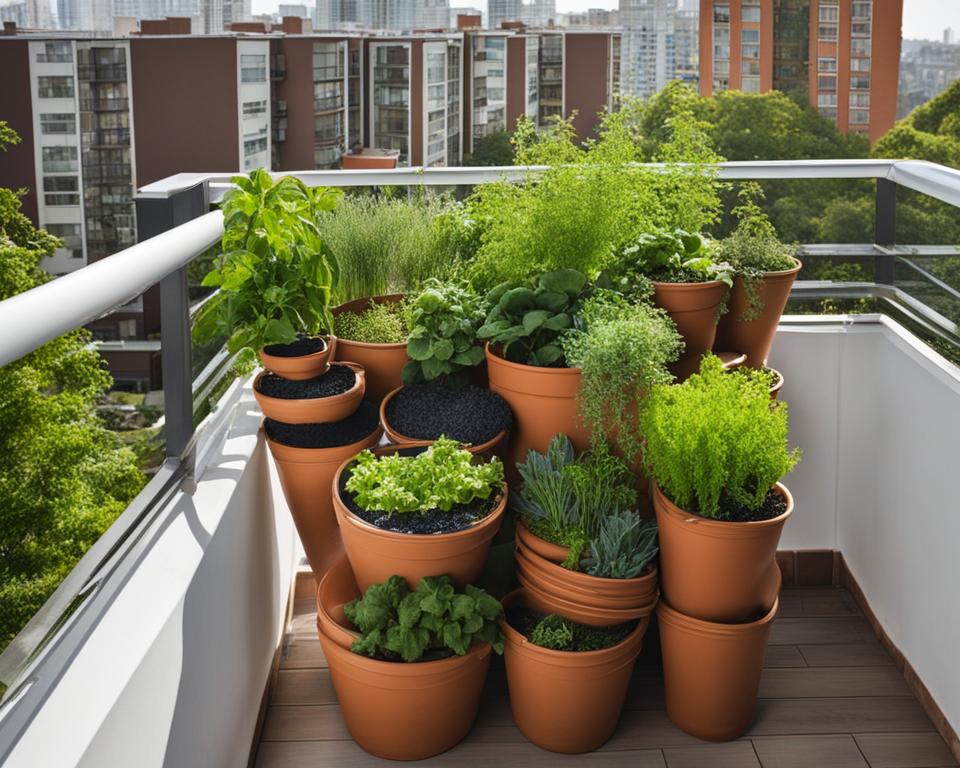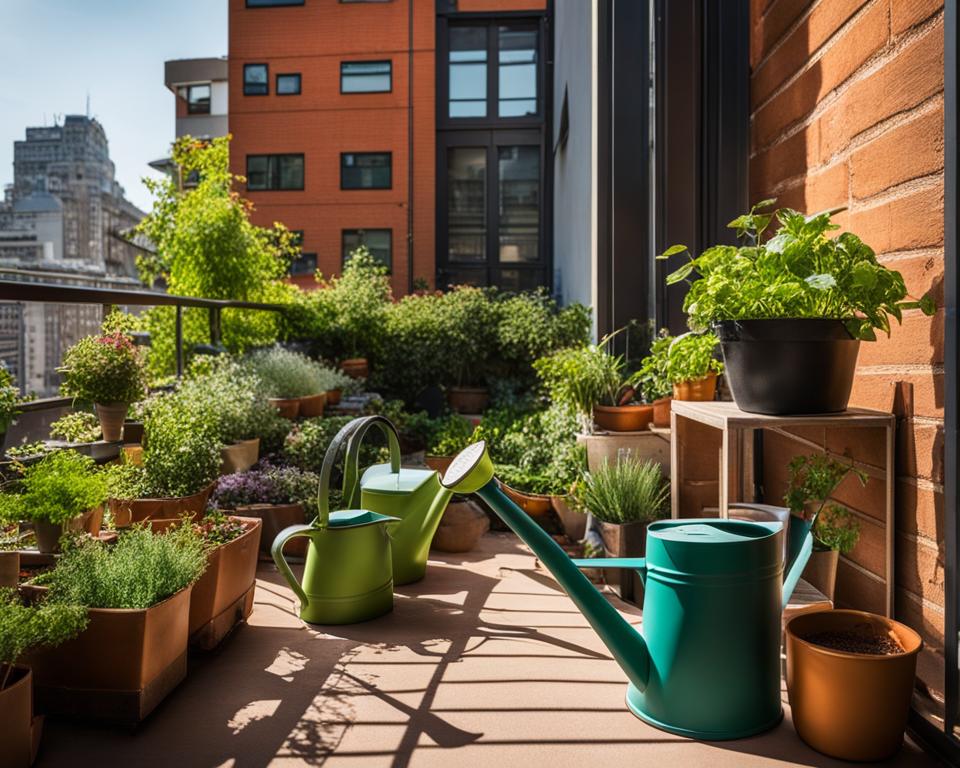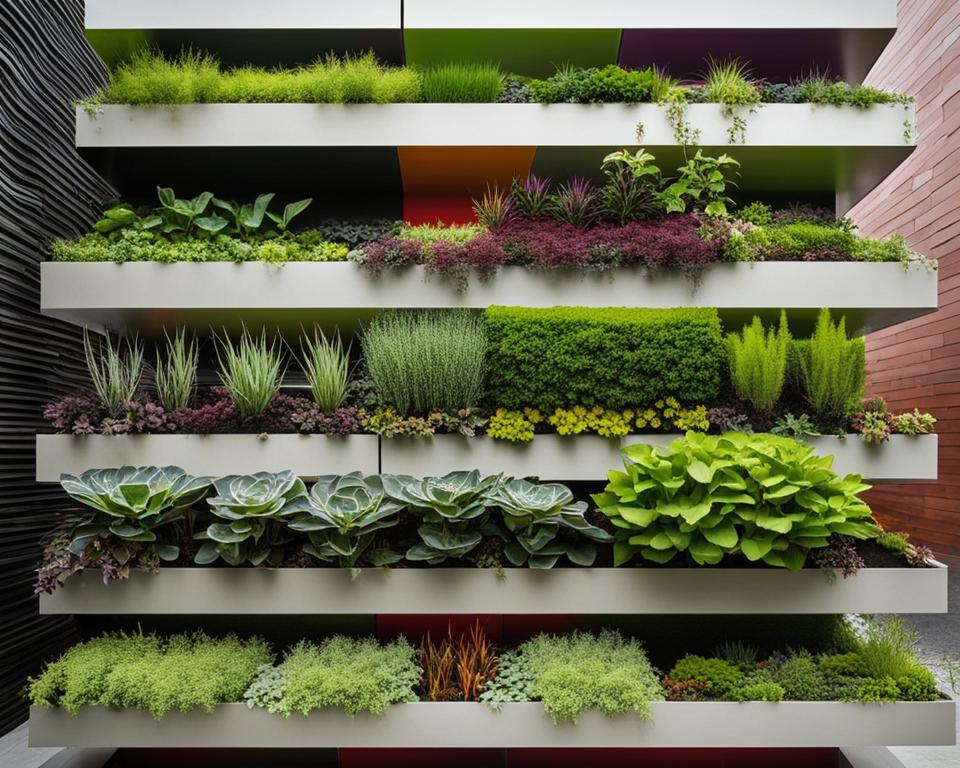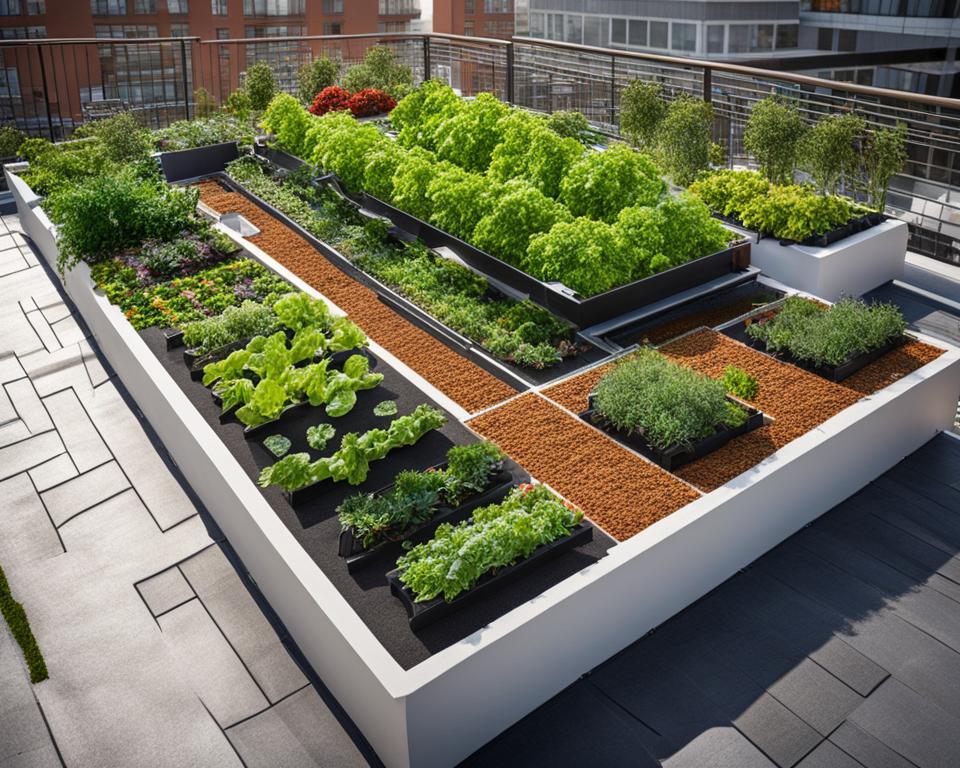Ever thought your city abode couldn’t house a slice of the countryside? Think again. Urban vegetable gardening is not only possible, it’s flourishing, bringing a fresh twist to metropolitan living. Whether you’re working with a quaint balcony or a panoramic rooftop, inventive urban vegetable gardening ideas can help you create your own verdant oasis. Imagine stepping out into your slice of outdoor heaven to pluck a ripe tomato off the vine or harvest a crisp lettuce for dinner—sounds divine, doesn’t it?
Luckily, small space gardening is adaptable, and as you dwell in the heart of the city, you can still embrace the rhythms of nature. With a clever setup using container gardening methods, your vibrant garden will be the envy of your urban neighborhood. You don’t need acres of land to feel like a proud green thumb – a sunny corner and a collection of pots are all it takes to transform your living space into a productive mini farm.
Key Takeaways
- Make the most of vertical spaces to expand your garden without sacrificing square footage.
- Choose the right containers to meet the needs of different vegetables; bigger isn’t always better.
- Maximize sunlight exposure by positioning your garden in the brightest area of your space.
- Root crops like potatoes and carrots can also prosper in an urban setting with the proper container depth.
- Regular watering and adequate drainage are essential to avoid waterlogging and maintain plant health.
- Gardening in the city can yield ample produce even within the constraints of a modest balcony or rooftop.
- Consider companion planting for a more productive and visually appealing urban garden landscape.
Embracing Urban Vegetable Gardening: A Comprehensive Guide
Transforming your urban space into a green oasis is not just a trend, but a lifestyle adaptation promoting sustainability and well-being. Urban vegetable gardening design isn’t merely about the aesthetic pleasure; it’s about forming a functional and engaging living area. As you embark on this green journey, let’s explore what it means to create a thriving garden in the heart of the city.
What Defines an Urban Vegetable Garden
An urban vegetable garden is a testament to the ingenuity of city dwellers, where every sliver of space can be converted into a productive plot. Whether it’s a cluster of herb pots on a windowsill or a full-fledged tomato garden on a rooftop, these are lush patches that challenge conventional spaces and turn urban areas into places of growth and vitality.
Incorporating elements of edible landscaping into your garden design brings a sensory richness to your living space, merging the lines between the edible and the ornamental. This approach assures that your endeavor is not only practical but also picturesque.
Maximizing Your Limited Space
- Think Vertically: Utilizing vertical spaces can exponentially increase your planting area. Install shelves, hanging planters, or trellises to take advantage of upward space for crops like beans and vining cucumbers.
- Choose Multi-Purpose Varieties: Some plants, such as cherry tomatoes or peppermints, provide both aesthetic appeal and edible rewards. Positioning them strategically can enhance both the look and productivity of your garden.
- Maximize Container Potential: Containers are one of the most versatile tools in urban gardening, enabling you to grow a variety of produce in the most compact of spaces. Look for varieties bred for container living to ensure success.
With the right urban gardening tips and approaches, even the smallest of areas can yield a bounty of fresh produce. This is where square foot gardening and the resourceful use of containers come into play, allowing you to make the most of every inch available to you.
Benefits of Growing Your Own Urban Garden
Urban gardens are about more than just aesthetics; they’re about creating a sustainable and self-sufficient lifestyle. Imagine the satisfaction of plucking fresh bell peppers for your meals right from your balcony, or the joy of watching your children discover the wonders of nature through the lifecycle of a strawberry plant. The psychological and physical health benefits of gardening are well-documented, contributing significantly to stress reduction and overall happiness.
Not to mention, the ecological impact of reducing your carbon footprint by consuming homegrown produce is substantial. By embracing urban vegetable gardening design, you not only beautify your surroundings but also contribute to a more sustainable planet, one plant at a time.
Container Gardening: Cultivating Edibles in Tight Spaces

When your outdoor space is nothing more than a small patio or balcony, small space gardening can be a delightful challenge. This is where container gardening shines as a method of nurturing an array of edibles in a constrained urban environment. The versatility of containers allows you the freedom to grow a garden that not only fits into tight spaces but also enhances the aesthetic of your urban abode with lush greenery and fresh produce. Below, discover essential tips for using containers effectively in your urban garden, incorporating urban gardening hacks to maximize your yield and enjoy a bountiful harvest.
Choosing Containers for Different Vegetable Types
Understanding the unique needs of each vegetable you wish to grow is key in selecting the perfect container. Larger vegetables such as tomatoes and beans require deeper containers to accommodate their extensive root systems, while herbs, lettuces, and radishes will be content in shallower pots. This customizable aspect of container gardening allows you to tailor your choices to the specific requirements of your plants, ensuring they have the room they require to thrive.
Ideas for Upcycled Planters
Looking for resourceful urban gardening hacks? Consider upcycling common household items into creative planters. Old buckets, wooden crates, and even colorful tin cans can be transformed into attractive and functional homes for your plants. The key is to ensure proper drainage, so your creative containers keep roots healthy and free from rot. Here’s a tip: Drill holes in the bottom of your upcycled planters and place them on bricks or feet to allow excess water to escape. Your garden will be both eco-friendly and full of character.
Watering and Drainage Best Practices
- Water container plants early in the morning to allow foliage to dry before the cooler evening temperatures arrive.
- Use a watering can with a long spout to directly water the soil, not the leaves, to reduce the risk of plant diseases.
- Check the moisture level of the soil regularly; container soil dries out faster than ground soil, so you may need to water more frequently.
- Consider self-watering containers with built-in reservoirs for a more consistent moisture supply, which can be particularly useful for thirsty plants during the peak summer months.
- Employ saucers beneath pots to catch excess water, but don’t let your plants sit in standing water which can lead to root rot.
Adhering to these best practices for watering and drainage will provide a solid foundation for your container garden to flourish. Remember, in the world of container gardening, attention to detail is a small price to pay for the immense satisfaction of harvesting your very own urban-grown vegetables.
Small Scale Solutions: Urban Vegetable Gardening Ideas
Living in the city doesn’t mean you have to give up on the dream of having your own garden. Urban vegetable gardening ideas like square foot gardening, vertical gardening, and edible landscaping can turn even the smallest spaces into lush, productive areas.
Implementing Square Foot Gardening
Square foot gardening optimizes space by dividing the growing area into small square sections (typically 1×1 foot) that can be managed individually. This method is a boon for urban gardens, as it allows you to grow a variety of vegetables in a concise space. Here’s how you can start your own square foot garden:
- Plan Your Space: Measure out your garden bed and divide it into one-foot squares using a grid of strings or wooden sticks.
- Select Your Seeds: Choose a variety of seeds suitable for this type of gardening; think about companion planting to boost your garden’s efficacy.
- Plant and Maintain: Follow the specific planting guidelines for each vegetable, keeping in mind their space requirements.
Utilizing Vertical Spaces Effectively
When the ground area is at a premium, turning your gaze upwards opens an array of gardening opportunities. Vertical gardening takes advantage of walls, trellises, and climbing plants to grow vegetables in a visually appealing, space-saving manner. To get started on your vertical garden:
- Choose a Wall or Fence: Ensure that it’s sturdy enough to support the weight of plants.
- Install Shelving or Trellis: This will be the support system for your plants to grow upon.
- Plant Vertically Grow Vegetables: Staple vertical gardening favorites like tomatoes, peas, or pole beans near your trellis.
Creating an Edible Landscape on Your Balcony or Patio
Edible landscaping transforms your balcony or patio into a delightful blend of form and function. It involves selecting plants not just for their nutritional value but also for their aesthetic appeal. Here’s a simple guide to curating your edible landscape:
- Select plants with different heights, colors, and textures to create a visually engaging space.
- Use planters and pots that complement your outdoor furniture, enhancing the overall look of your patio or balcony.
- Incorporate herbs and edible flowers for a pop of color and to add fresh flavors to your dishes.
| Method | Space Required | Best Plants | Maintenance Level |
|---|---|---|---|
| Square Foot Gardening | 1’x1′ per section | Leafy greens, radishes, onions | Medium |
| Vertical Gardening | Vertical plane | Climbing beans, peas, cucumbers | High |
| Edible Landscaping | Varies by design | Herbs, strawberries, chard | Low to Medium |
These urban vegetable gardening ideas are not only functional but also transform your living space into an oasis in the city. Start small, and as you become more comfortable, watch your space grow into a haven of greenery and sustenance.
The Joys of Balcony Gardening

Transforming your balcony into a verdant oasis is not just about embellishing your urban space—it’s a lifestyle. Cultivating a garden on your balcony brings not only the freshness of greenery but also the pleasure of growing your own food. In this guide, we will explore essential tips for successful balcony gardening, from managing sunlight exposure to choosing the best plants and accessories for your container garden.
Tips for Sunlight Management
Whether your balcony receives a flood of sunlight or a milder dose of ambient light, understanding sunlight management is central to your gardening success. Take note of how the light moves across your space throughout the day and arrange your plants accordingly to ensure they receive the right amount of sunshine for their growth needs. Reflective surfaces and light-colored walls can help to brighten shadowed areas, optimally distributing light across all your plants.
Selecting Plants Suited for Balcony Environments
The secret to a lush balcony garden lies in selecting the right plants. Look for varieties known to thrive in the sheltered, yet sometimes varied conditions of a balcony setting. Here’s a table to help you decide:
| Vegetable | Sun Exposure | Container Size |
|---|---|---|
| Lettuce | Partial to full sun | Small to medium |
| Tomatoes | Full sun | Large |
| Cucumbers | Full sun | Medium to large |
| Herbs (Basil, Mint, Thyme) | Full to partial sun | Small |
Consider both the microclimate of your balcony and the care requirements of each type of vegetable to ensure a harmonious and productive container gardening experience.
Accessorizing Your Balcony Garden
To truly personalize your space, accessorizing is key. Merge functionality with style through the use of vertical planters or railing boxes, which not only save space but also showcase your plants beautifully. Chic containers in various textures and colors can complement your urban gardening design, making your balcony both an aesthetic delight and a culinary treasure trove.
Remember, a balcony garden is more than just potted plants—it’s a reflection of your ingenuity in creating a green sanctuary within the confines of the urban concrete jungle.
Rooftop Gardening: Elevating Your Urban Agriculture

Imagine transforming the unused space above your apartment into a green oasis where vegetables thrive and you can enjoy fresh air and privacy. Rooftop gardening isn’t just a trend; it’s a way to bring nature into your urban life, making the most of small space gardening opportunities. Before you start carrying soil and planters upstairs, let’s cover a few essential aspects to ensure that your rooftop garden is both safe and successful.
Ensuring Structural Safety and Compliance
Before planting your first seed, it’s crucial to evaluate the structural integrity of the building. Check with a structural engineer to determine how much weight your roof can support and stay compliant with city codes. It’s not only about rooftop gardening, it’s about safety first for you and your neighbors.
Lightweight Gardening Techniques and Materials
Once you have the green light, consider using lightweight gardening materials. Fiberglass or foam planters can be excellent options that won’t add unnecessary weight to your roof. Additionally, using a lightweight potting mix will help ease the load and allow for better root growth and drainage.
Managing Weather Extremes on Rooftops
Rooftops can be extreme environments for plants due to higher wind speeds and more direct sunlight. Employ lattices or trellises to provide your plants with some protection against the elements. In addition, consider installing a water collection system to make the most of the rainfall, an urban gardening tip that not only conserves water but also prevents runoff from flooding your downstairs neighbors.
With the right preparations, rooftop gardening becomes not just a dream, but a practical extension of your living space. It’s all about maximizing potential in every square foot and turning the city’s skyline into a verdant tapestry of your own creation. So roll up your sleeves, because the sky isn’t just above you, it’s the future site of your urban garden.
Vertical Gardening: Creative Urban Gardening Design

When you embrace vertical gardening, you not only embrace a form of urban vegetable gardening design that saves space but also adopt smart urban gardening hacks that enhance the aesthetics and yield of your garden. This efficient approach allows city dwellers with limited horizontal space to develop lush vegetable gardens that rise upwards, bringing life to concrete landscapes and providing a bounty of fresh produce. Let’s explore how you can utilize this innovative method in your urban oasis.
Using Trellises and Wall Planters
Whether you’re looking to support your climbing vegetables like cucumbers and tomatoes, or add decorative green walls of trailing vines and herbs, trellises and wall planters are your allies. They provide the necessary support for plants to grow vertically, saving ground space while creating an attractive green area. Moreover, these structures can be both bought ready-made or custom-built to fit your specific urban gardening needs.
Advantages of Growing Upwards
Growing upwards has numerous benefits; air circulation around plants is improved, which can help reduce the risk of pests and diseases. Moreover, plants growing on trellises or in vertical arrangements often gain better access to sunlight, which is a commodity in the densely built environment of a city. You’ll be surprised to find that your vertical garden can yield a significant harvest, often more than a traditional garden bed would offer in the same footprint.
Vertical Gardening for Beauty and Yield
Beyond functionality, a vertical garden is a picturesque feature that brings a dash of nature’s serenity to the urban bustle. It can transform your living space into a green haven and become a focal point for relaxation and enjoyment. Plus, the high density of plants not only increases your garden’s productivity but also contributes to urban biodiversity, inviting beneficial insects and providing pockets of greenery for the environment. Get creative with the layout and the types of plants you choose to maximize both the visual appeal and the harvest from your vertical garden.
Innovative Urban Gardening Hacks
As you delve into the world of urban gardening, there’s a treasure trove of ingenious urban gardening hacks to help you optimize your produce and enjoyment levels. Whether you’re challenged by limited square footage or just looking to add a creative flair to your green space, these urban gardening tips will help you achieve a lush and vibrant garden within your concrete confines.
For starters, think vertically. Spaces like walls or balcony railings are often underutilized in small space gardening. Widen your field of vision and embrace the vertical plane—consider investing in a sturdy trellis or create your own hanging systems for planters to literally take your garden to new heights.
Let’s put these hacks into context with an easy-to-follow guide:
| Urban Gardening Hack | Description | Benefits |
|---|---|---|
| Hanging shoe organizer planter | Repurpose an over-the-door shoe organizer as a series of vertical planter pockets. | Space-saving and cost-effective. |
| Pallet wall gardens | Mount pallets against a wall and use the slats to hold pots or create planting rows. | Recycles materials and provides a rustic look. |
| Plastic bottle planters | Cut out openings in old plastic bottles, fill with soil, and use to grow smaller plants. | Sustainable use of single-use plastics and adaptable to a variety of spaces. |
| Rain gutter gardens | Install old rain gutters along a wall or fence and plant with greens or herbs. | Easy to install and perfect for linear plantings like strawberries or lettuce. |
| Windowsill herb gardens | Utilize windowsills to keep small pots of herbs, providing easy access for cooking. | Maximizes unused space and enhances cooking with fresh ingredients. |
Remember, the key to a flourishing urban oasis is not just the vision, but embracing innovation. With these urban gardening hacks, you can transform even the most cramped balcony or patio into a thriving edible garden. It’s time to sow the seeds of resourcefulness; happy gardening!
Edible Landscaping: Merging Aesthetics with Utility
In the realm of urban gardening design, the innovative approach of edible landscaping has gained momentum as an insightful fusion of form and function. As an urban gardener, imagine being able to pluck sun-ripened tomatoes and fresh basil right from your living balcony art piece or stepping out into a patio arranged with rows of rainbow chard that paint a verdant tapestry. This concept pushes beyond traditional gardening methods, allowing you to see your plants not only as food sources but also as elements of beauty. By integrating edible plants with ornamental ones, you cultivate a space that is both visually and gastronomically rewarding.
Your creative potential is limitless with edible landscaping. You may wish to introduce symmetry with patterns of lettuces and kale, or add texture and height differences with thriving herb clumps alongside your leafy vegetables. The essence of this garden style lies in its dual-purpose nature—each plant adds to the visual appeal while waiting to be transformed into part of a meal. Moreover, the practice of vertical gardening within an edible landscape offers an extra dimension, enabling you to grow climbing plants like beans and cucumbers, which doubles as a living green wall that saves space while adding to your garden’s lush appearance.
Visualize your urban space with this sustainable philosophy—every section serves multiple purposes, each container is chosen for both function and form, and all your gardening choices are made with an eye for both utility and aesthetics. You, as the architect of your own edible landscape, can enjoy the serene beauty of nature’s palette outside your window while supporting your well-being with fresh, homegrown produce. Embrace this harmonious blend of the artful and the edible to truly revolutionize the way you view and use your urban gardening space.
FAQ
How do I start an urban vegetable garden in a small space?
Begin by assessing your available space such as a balcony, patio, or windowsill. Choose suitable containers or plan a square foot garden if you have a little more room. Select vegetables that grow well in small spaces and ensure they receive adequate sunlight and water. Vertical structures like trellises and wall planters can help you make the most of limited space.
What are some creative urban vegetable gardening ideas?
Consider container gardening, vertical gardening with trellises or wall-mounted systems, square foot gardening for organization, and even rooftop gardening if structure allows. Include a mix of edible landscaping elements to maximize both beauty and yield.
Can I grow a variety of vegetables in an urban garden?
Absolutely! You can cultivate a wide range of vegetables such as lettuce, tomatoes, peppers, and herbs. Container size can dictate the variety of vegetables you grow, while vertical gardening allows you to expand the types of vegetables by growing upwards.
What defines an urban vegetable garden?
An urban vegetable garden is a creative use of limited or unconventional spaces within a city environment to grow vegetables, herbs, and fruits. Examples include growing plants on balconies, rooftops, patios, and in containers or raised beds.
How do I ensure my containers have proper drainage?
Ensure each container has holes at the bottom for excess water to escape. You can also place stones or gravel at the bottom of the pots before adding soil, to improve drainage. Using saucers under containers can help catch runoff water, but make sure to empty them to avoid root rot.
What benefits does urban gardening offer?
Urban gardening provides numerous benefits including access to fresh produce, aesthetic enhancement of your living space, a form of physical and mental relaxation, and the satisfaction of growing your own food. It can also contribute to a greener environment and reduce your carbon footprint.
How can I incorporate vertical gardening in my urban space?
You can use vertical structures like trellises, garden nets, wall planters, and hanging baskets to grow plants upwards, which saves space and can lead to healthier plants and higher yields. Vertical gardening can also add an attractive dimension to your urban space.
What are some urban gardening hacks I can use?
Maximize your space with container stacking, repurpose household items like shoe organizers, wooden pallets, or plastic bottles as planters. Implement drip irrigation systems from recycled materials for efficient watering, and choose companion planting to enhance growth and deter pests.
What should I consider when creating an edible landscape?
Think about aesthetics as well as utility—choose a variety of plants for their color, texture, and size as well as their edibility. Design your planting layout to include both ornamental and edible plants, creating a landscape that is both beautiful and functional.
How do I manage sunlight for my balcony garden?
Determine the sunlight pattern of your balcony throughout the day. Choose plants that are suited for the amount of direct light available. Use plant stands or hanging systems to adjust the heights of plants, ensuring they receive adequate sunlight.
Are there lightweight options for rooftop gardening to reduce load?
Yes, opt for lightweight containers made from materials like fiberglass or foam, and use a lightweight potting mix. Raised beds can also be constructed with lighter materials to reduce weight on your rooftop.
How can I ensure my rooftop or balcony garden is safe and complies with regulations?
Check with building management or local authorities for regulations regarding rooftop and balcony usage. Ensure you’re not exceeding weight limits and that your gardening setup does not interfere with building safety or access. Employ a professional if any structural assessments or modifications are needed.

